The adaptable aspen lives across the globe, from snowy high-elevation forests to dry deserts. But can this circumglobal super species adapt to a changing climate?
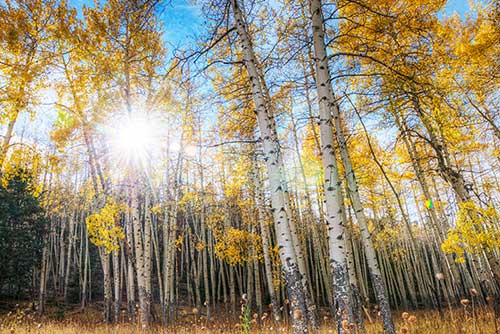
By Tyler Williams
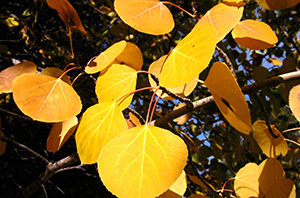
Imagine a world of idyll, where a chorus of wavering lime-green leaves creates an ethereal backdrop to columns of bright white trunks. Ferns grow waist high; songbirds flit, matching the symphonic flutter of the leaves. This is an aspen grove, one of millions that make our world a natural paradise.
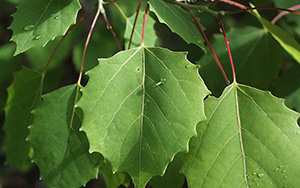
It’s no wonder that the word “aspen” has served as a title for perfumes, iconic mountain towns and children’s names. We love this tree, and there are a lot of them to love. Aspen range from the barren fringes of Alaska’s Brooks Range to the fecund tropical highlands of central Mexico. They intermingle with hardwood forests in West Virginia, dominate the North Woods of Wisconsin and carpet mountainsides of the American West. Quaking aspen (Populus tremuloides) is the most widely distributed tree in North America, and its cousins reach around the world. In the Far East, there is Chinese aspen (Populus adenopoda) and Japanese aspen (Populus sieboldii). Eurasia and northern Africa harbor European aspen (Populus tremula), the aspen species most similar to North America’s P. tremuloides. In fact, aspen is so adaptable that it is one of a select group of trees dubbed “circumglobal super species,” spanning continents in strikingly similar forms.
With such wide-ranging parameters, one might think that aspen would be nicely poised to bend with the curves of climate change. Unfortunately for aspen — and for the myriad species that call aspen groves home and communities that depend on aspen to help regulate their water supply — just the opposite could be true. And given aspen’s global presence, ecosystems around the world could experience the consequences.
THE ADAPTABLE ASPEN

Here in North America, we have two aspen: the common P. tremuloides and bigtooth aspen (Populus grandidentata), distinguished by its darker bark and bigger leaves. Bigtooth aspen grow from Missouri to Quebec and west to North Dakota, but the species curiously hybridizes with P. tremuloides in a disjunct population along Nebraska’s Niobrara River. This isolated aspen melting pot is a unique ice age remnant, where aspen, once common across the Pleistocene Great Plains, has held on in a sheltered cold pocket after the glaciers receded. As unusual as the Niobrara population is, it’s not the only hybridization of aspen. In Alaska, black cottonwoods (Populus trichocarpa) have been documented to hybridize, in rare instances, with P. tremuloides.

Despite the different varieties, aspen is easily recognized whether in Mexico or Manitoba. No other tree has that familiar quiver that gives the tree its common name, quaking aspen — or sometimes trembling aspen. Its leaves are distinctly shaped — rounded, nearly heart-shaped and finely saw-toothed. The bark is almost always whitish, but varies significantly with region and age. In Arizona, trunks are often so clean and white that they look artificially painted, but a beige-white or green tint is most common, indicative of the photosynthesis that takes place through aspen bark. Older trees develop grayish, furrowed bark. Not that many aspen get the opportunity to develop these wrinkles of wisdom, however, because aspen is a relatively short-lived tree. Quaking aspen has an average lifespan of 60-70 years, while bigtooth aspen may live closer to 100 years. There are anomalies, though.
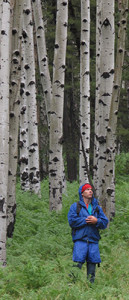
The oldest recorded aspen was 226 years old. It grew in California’s White Mountains, the same rot-free environment that produces 4,000-yearold bristelcone pine — the world’s oldest trees. By contrast, the humid and dynamic climate of the upper Midwest yields lifespans of just 60 to 75 years, a product of persistent rot sometimes followed by violent winds. Drier, less fungal environments aid in aspen longevity, and although any P. tremuloides more than 200 years of age is rare, many specimens in the West survive for well more than a century. These older trees of the West also have time on their side when it comes to attaining maximum size. Before 2007, the national champion P. tremuloides grew in eastern Oregon. The current champ hails surprisingly from the Pinaleno Mountains of southeastern Arizona, a vertically prominent range in Coronado National Forest known as a sky island because of its botanical isolation amidst the desert valleys that surround it. The Pinaleno aspen grows 130 feet tall with a four-foot diameter trunk, about twice the size of a thriving, mature, average tree.
But average is hardly a word one can use with this species, for aspen can grow as a stunted subalpine hedge, a spindly and tall canyon dweller or a maze of crooked trunks, bent into incomprehensible “s”-turns by winter’s drifting snow. Most aspen habitats hold at least a modest snowpack because one thing this adaptable species requires is a high water table. Aspen only thrives where annual precipitation exceeds annual evapotranspiration. That can come as 40 inches of rainfall in Mexican highlands or six inches of water stored in a dry Alaskan snowpack that persists for nine months a year.

ASPEN IN DECLINE
What could be the culprit in the decline of a tree that has proven itself able to survive in such variable conditions? The answer may not be as simple as we once believed.
Aspen die-offs have been recognized in various regions of North America over the past half century, from British Columbia’s Kootenay Region to Wyoming’s Yellowstone National Park to New Mexico’s Gila Wilderness. The culprits for these declines, it was generally agreed, were fire suppression and elk browsing. Aspen is a pioneer species after a burn, taking advantage of the loss of shade-producing conifers to soak up the sun. So, no fire, no new aspen groves. When a new grove does begin to develop, ungulates — primarily elk, their numbers having risen with the loss of their natural predators — swoop in vigorously, hungry for the fresh young saplings.
This meant loss of habitat for all the critters that prefer or depend on aspen groves for their homes. Snowpack also generally melts faster if aspen are not present, which can cause increased flooding downstream and trouble for communities whose water supply depends on the snowpack. And aspen groves help prevent wildfires from spreading, meaning that their loss leaves communities in hot, dry regions of the West more vulnerable. The silver lining was that fire and game could be managed by land agencies, allowing us an opportunity to deal with aspen decline.

Or so we thought. In the early 2000s, major aspen failures were recognized in eastern and western Canada, the central Rockies and the Southwest. This was a different kind of die-back, coined SAD — Sudden Aspen Decline — by forest pathologist James Worrall. Aspen groves over wide areas were dying rapidly, unlike the generalized landscape shifts of the past. The new millennia seemed to bring a new paradigm, where the old answers — more fire and less elk — no longer worked. Now, looking back with a decade of hindsight, the aspen conundrum seems obvious.
From 2000 to 2003, drought persisted in all of the aforementioned die-off regions, and temperatures were higher than average, sometimes record high. The century began with the warmest six-month period on record in New Mexico and the second warmest for Arizona, Colorado and Utah. The next year, 2001, provided some relief to those areas in the form of near-normal snowpacks, but nationwide, the year made the top five for all-time hottest. In 2002, the heat stayed on — it was the third hottest year on record in the Southwest — and it was coupled with unprecedented drought. For many aspen groves, this was the tipping point.

Aspen are more sensitive to drought than their coniferous counterparts because each spring, they must put energy into a glorious green transpiring leaf. A major grove can produce enough transpiring leaves to create a micro climate of cooler temperatures and higher humidities, capable of repelling crown fires that gobble adjacent pine and fir stands. Along Arizona’s San Francisco Peaks, the devastating Schultz Fire of 2010 left aspen groves standing in stark green contrast to the charred landscape that surrounded them on all sides. Stopping a wildfire takes serious energy, requiring a tree to suck moisture through its roots, up its trunk, out its limbs, into its leaves and out to the world. When a severe drought exists, there just isn’t enough juice to feed the cycle. Aspen are unable to pump enough water to their crowns through a process scientists call “xylem cavitation.” If a drought-stressed tree is unable to do this, the affliction is known as “hydraulic failure.”

Effects were not apparent right away, but by 2004, widespread dead and dying aspen were recognizable. By 2006, another hot and dry year, 150,000 acres of aspen were documented as dying in Colorado alone. Alberta and Saskatchewan showed a 35 percent aspen mortality rate. In Arizona, groves near their lower-elevation threshold were 90 percent dead.
It takes a dramatic drought and high temperatures to induce this scenario, but even mildly warm and dry conditions can stress aspen enough to make them susceptible to insect attack from tent caterpillars, oystershell scales and poplar borers. Like mountain pine beetles[see American Forests Fall 2012], poplar borers are having a population boom due to fewer extended cold snaps in winter and fewer killing frosts in spring and fall — symptoms of climate change. When a late freeze does arrive to mercifully reduce the borers, aspen can still be doomed if an early thaw — another symptom of climate change — has prematurely melted the insulating snowpack, as aspen roots can be damaged by severe cold.
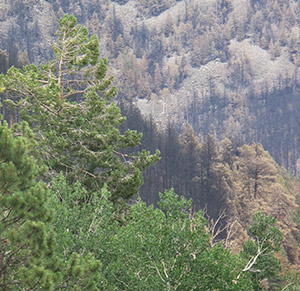
THE FUTURE OF ASPEN
So what does the future hold for aspen in a warming world? The answers may depend in part on how the aspen reproduce. Aspen have two means of reproduction: Some are seed spreaders, and some are sprouters. In the East, where aspen are seeders — reproducing via cottony seeds floating on the wind — the future looks brighter. Like many trees, they may be able to simply move up in elevation to find suitable habitats in a warmer world. However, aspen is not a dominant species in these forests, nor is it likely to be in the future.
In the West, where aspen play a bigger role in forest composition, they might be slower to make the transition because there, they are sprouters, not seed spreaders. Most aspen in the West reproduce from the roots of existing trees, sprouting new trunks, called ramets, in a steady march across the landscape. Entire groves, then, can be clones of a single original tree.
The largest of these clonal groves ever documented is a 108-acre stand in Utah called “Pando,” Latin for “I spread.” The Pando Grove contains more than 40,000 trees and is estimated to have existed for at least tens of thousands of years. For a single clonal grove to be successful, it must have just enough disturbance to keep conifers from taking over, while escaping any grove-eliminating catastrophic events. Pando, in the rolling snow-covered plateau country of central Utah, has found that perfect place.
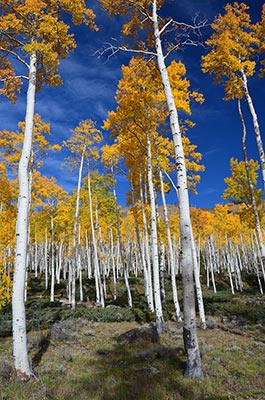
Groves of clones like Pando add a unique beauty to the landscape: They can be distinguished from neighboring aspen families during spring, when the trees leaf out, because a single clonal grove will usually leaf at the same time. The same visible distinctions are seen in autumn, when aspen turn their brilliant yellow and orange, sometimes directly adjacent to a grove that still retains its summer green.
Fall colors in the relatively drab West might be the single most attractive element of aspen to humans, but food and shelter are primary drivers for a multitude of animal species that call aspen groves home. Mice, voles, picas, rabbits, beaver, porcupine, deer, moose and elk all prefer aspen-dominated habitats. Ruffed grouse depend on them for forage, breeding and nesting. Goshawk, Cooper’s hawk, sharp-shinned hawk and pygmy owl nest and hunt and live there, too.
For these aspen-loving species, the forecast doesn’t look good. On the one hand, more droughts and warmer temperatures — conditions forecasted by most climate scientists for much of the aspen’s prime range — spell disaster for this moisture-loving species. There is little doubt that in marginal habitats — Arizona’s pine-oak woodlands, Colorado’s south-facing slopes, Alberta’s prairie edges — aspen is on its way out. Conversely, more forest fires could open new habitat for aspen, and some studies have shown an increase in atmospheric carbon dioxide aids aspen, producing longer roots and faster growth rates. The prevailing consensus, however, is that while some areas might see more aspen in the years ahead, overall aspen range is retracting. “I think aspen will have a more difficult time adjusting to climate change than many other species,” says Dr. Kathryn Ireland, who researched aspen decline in the Southwest at Northern Arizona University’s School of Forestry.

In many ways, aspen is a resilient tree, boasting two means of reproduction, high levels of genetic variability and productive living bark. It’s little wonder that P. tremuloides spans from the Arctic Circle to the Tropic of Cancer. In a changing world, however, its time of glory might be waning. A lauded study by Gerald Rehfeldt of the U.S. Forest Service’s Rocky Mountain Research Station used three future climate models to extrapolate aspen success for the remainder of this century. The verdict? More than half of current aspen stands in the central Rockies will no longer be there by 2060. The huge iconic groves of the Rockies will have to rely on high-altitude fires to clear out spruce forests adjacent to existing aspen groves, where new ramets can crawl uphill. Will they be able to keep up? Only time will tell.
Tyler Williams is a big-tree hunter, adventure seeker and author of Big Tree Hikes of the Redwood Coast: A Guide to the Giants. To learn more, visit his website www.funhogpress.com.